You may be thinking about the word 'Pashtun'. First I will let you know about it.

Picture credit: Order.ritual.co
Pashtuns are the people live in Khyber Pakhtunkhwa Pakistan. They are also known as 'Pakhtoons' in our country. Pakhtoon often claims that in the current era as non-governmental organizations and NGOs are set up to perform social works, actually these are a new form of thousands of years old Pakhtoon rite called "Ashar". Even today, Ashar's glimpses are in every respect of Pakhtoon society.
>> What is Ashar? <<
Ashar is a rite in which one person of each house in every village participates. Ashar is organized for those personal works of villagers that can't be easily done individually as well as collective works. A special thing in this tradition is that these tasks are completed voluntarily without any compensation.
Ashar is organized for grass harvesting, building a new house or demolishing an old house, filling of under-construction house's roof, and cutting the woods to make food if there's a wedding ceremony in the village.
A special number of people participating in Ashar is not determined rather, the number depends on the nature of the work. Sometimes only one person in the neighborhood is invited who works all day long. But when Ashar is arranged for grass harvesting, this number may consist of 20 to 100 people or even more.
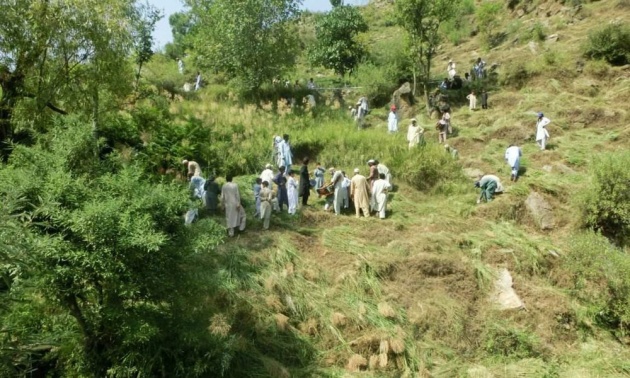
Ashar is organized for grass harvesting------- Picture credit: Naseeb yar
>> How is Ashar organized? <<
On the day when Ashar is intended to be arranged, before one or two days it is proclaimed at every house in the village that "We want to do a task tomorrow for which Ashar is being organized, kindly send one of your family members". Similarly, it is proclaimed at every house.
People arrive in a fixed place at Ashar's call, people even bring their own tools needed to perform work, then work begins in short order. Sometimes, people from the nearby village are also called for Ashar.
Ashar is organized in September and October in the upper areas of Khyber Pakhtunkhwa like Buner District, Shangla District, Torghar District, and Mansehra District. Before the arrival of frozen winter, the grass is harvested from the mountains to hoard grass for livestock. The major reason for this harvesting is that when the mountains are covered with ice sheets, the stored grass is the only thing that can be fed to animals.
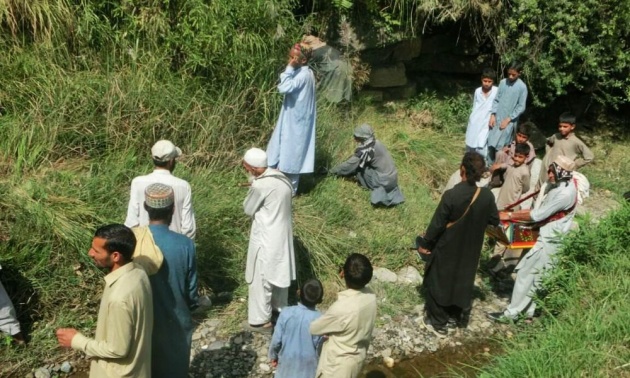
Music artists keep encouraging the villagers during Ashar------- Picture credit: Naseeb yar
>> The rite of Gobal <<
There is also another rite 'Gobal' associated with Ashar. The wheat should be cropped first to extract grain, then it is dried 1 or 2 days in the sunlight after that Gobal is organized.
The place where Gobal is organized called Darman. It is something that happens in Gobal that a strong wood is installed in the center of the ground, the wheat clusters are placed in vicinity of that wood, then with a strong rope, several bulls are tied with wood after that the bulls are run over the clusters due to which grain is separated from clusters. Ashar is also arranged for this Gobal and thus, to obtain the desired number of bulls the villagers (who owns the bulls) are asked to send their bulls.
Due to Ashar, where many days work is done in just a day, this ritual also provides an opportunity for mutual consensus and unification, brotherhood, and to share the pain of each other.
Ashar is generally called a ritual of working jointly without any compensation for others, but now this word is mostly attributed to grass harvesting.
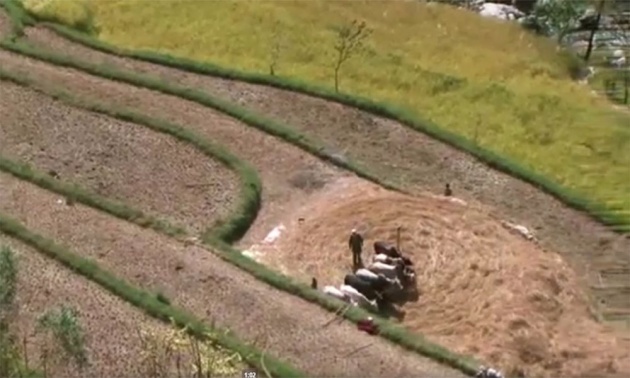
Gobal rite is being performed------- Picture credit: Naseeb yar
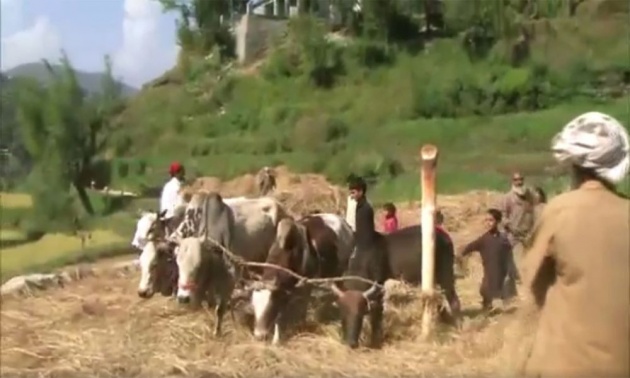
Bulls are being used for Gobal rite------- Picture credit: Naseeb yar
There is a share of almost every villagers on mountains and the part of the mountain where villagers harvest grass is called "Barkha" or "Paara" and villagers who take part in Ashar are called "Ashar Ganday". Everyone in the village knows their area on the hill. Barkha is generally far away from the village and sometimes it is as far that it takes one or two hours by foot where Ashar Ganday continuously harvest grass from morning till evening.
Video source: DawnNews via Youtube.com
It should also be noted that water springs are on a long distance from grass harvesting area so villagers fill 10 to 15 crocks from water spring and bring the crocks with them so that they can quench their thirst while working.
If the number of people is high in Ashar, the responsibility of bringing water is given to two or four villagers. Thus, a separate team is given responsibility for bringing lunch from home. After having lunch, tea is served in the crocks because there are also a number of onlookers in addition to the people in Ashar.
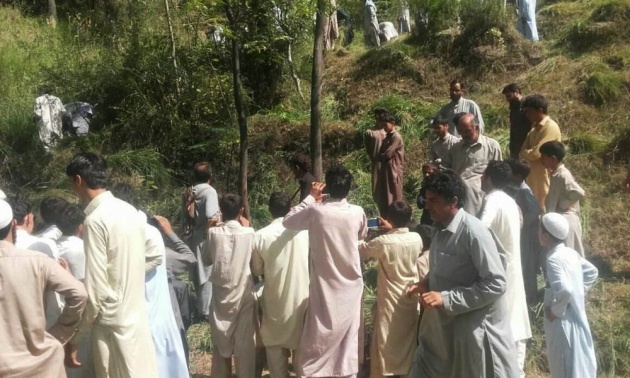
A large number of onlookers can be seen in addition to the villagers who take part in Ashar-------Picture credit: Naseeb yar
Dhol and harmonium players are also specially called to encourage villagers to work quickly. It is said that Ashar without music can be delayed and sometimes the required grass harvesting can't be completed, therefore, music becomes necessary so that villagers can complete their work quickly. The reason for this is that those people who work slackly the music players pursue that villager/group tenaciously so they fervently start harvesting grass under compulsion. This thing put in my mind one of an episode of Mr. Bean, once he also had to face the same situation in a restaurant when a violin player continuously playing in front of Mr. Bean and he had to finish his meal hastily. During harvesting, groups consist of 5 to 10 people are created, and then start a grass-harvesting competition.
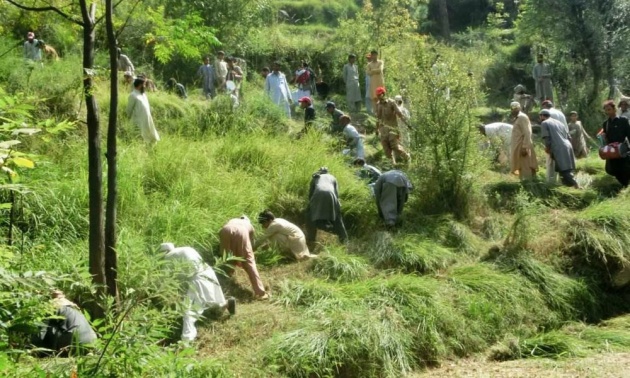
Groups can be seen during the harvesting-------Picture credit: Naseeb yar
During the competition, villagers shout slogans or start singing a song but everything is happening in a very pleasant environment and the whole day passes into a furious sunshine.
Often musical night is also organized after dinner to remove tiredness, after two or four hours, the party ends, but it is not necessary that the music party should be decorated after every Ashar.
Ashar: The concept of a welfare state and a rite
Apparently, Ashar and Gobal are a part of the tradition, in which people give hand to facilitate the work of each other. But in this old ritual, the principles of the modern democratic state seem to be implemented. For instance, today in our country the law is being made for one-dish in the marriage ceremonies that means people would not be allowed to make many food dishes in any marriage ceremony as the food is wasted in this way. While in the Pashtun society there has been a concept of one-dish for thousands of years. Although there is no comparison to the guests' hospitality of Pakhtoons but on the occasion of Ashar, always one dish is arranged. There is no difference between poor and rich in rituals like Ashar or Gobal no matter from where the Ashar's call came, people do participate without any difference.
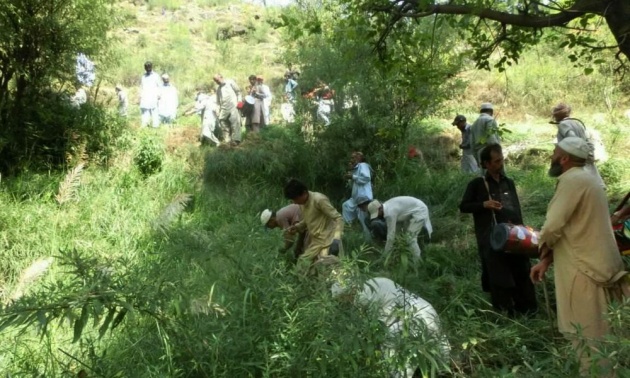
When a large number of people take part in the Ashar of grass harvesting-------Picture credit: Naseeb yar
It is also worth mentioning that if there is a widow or orphan in the village, is there any trouble, or difficulty at anybody's house, residents arrange Ashar for them, people reach themselves at the fixed time and work with full energy and dedication.
All the features mentioned here are seen in the concept of a welfare state.
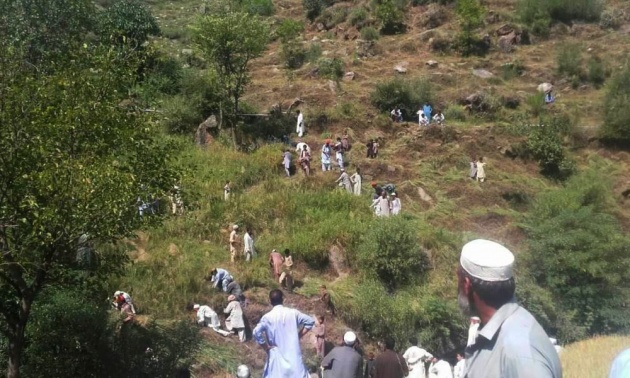
Ashar is an asset of Pakhtoon society-------Picture credit: Naseeb yar
Sadly, this modern era of development and technology has created individuality and thus, socially constructive collective customs are also breaking down. Ashar is also becoming one of them because nowadays Ashar is not as easily organized as it used to be before 20 to 25 years. Whatever the reason is, but we all need to maintain a good tradition in our society. According to time and conditions, their procedures can certainly be changed, but its main purpose should not be changed like helping another person by being selfless.
It would not be wrong to say that this ritual is the asset of Pakhtoon society and it is also a trust of elders, so its continuity should be maintained.



